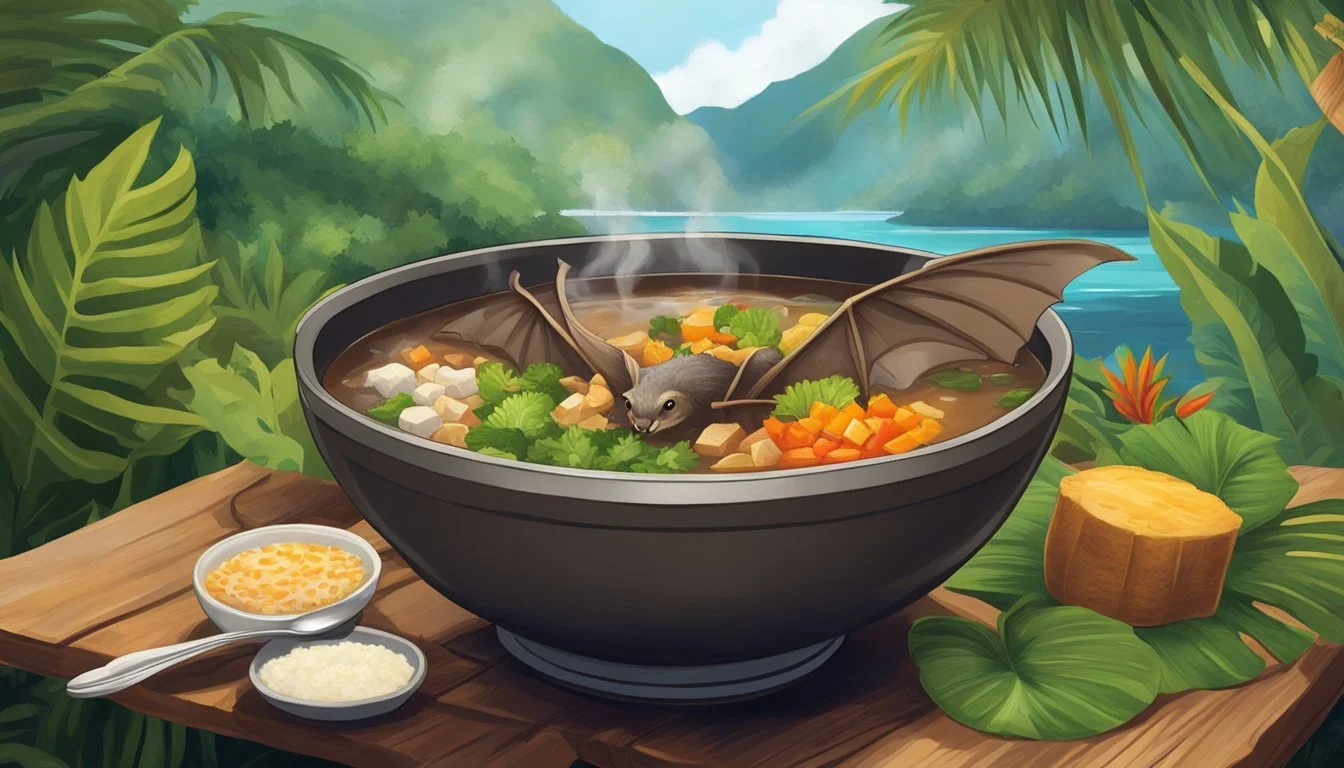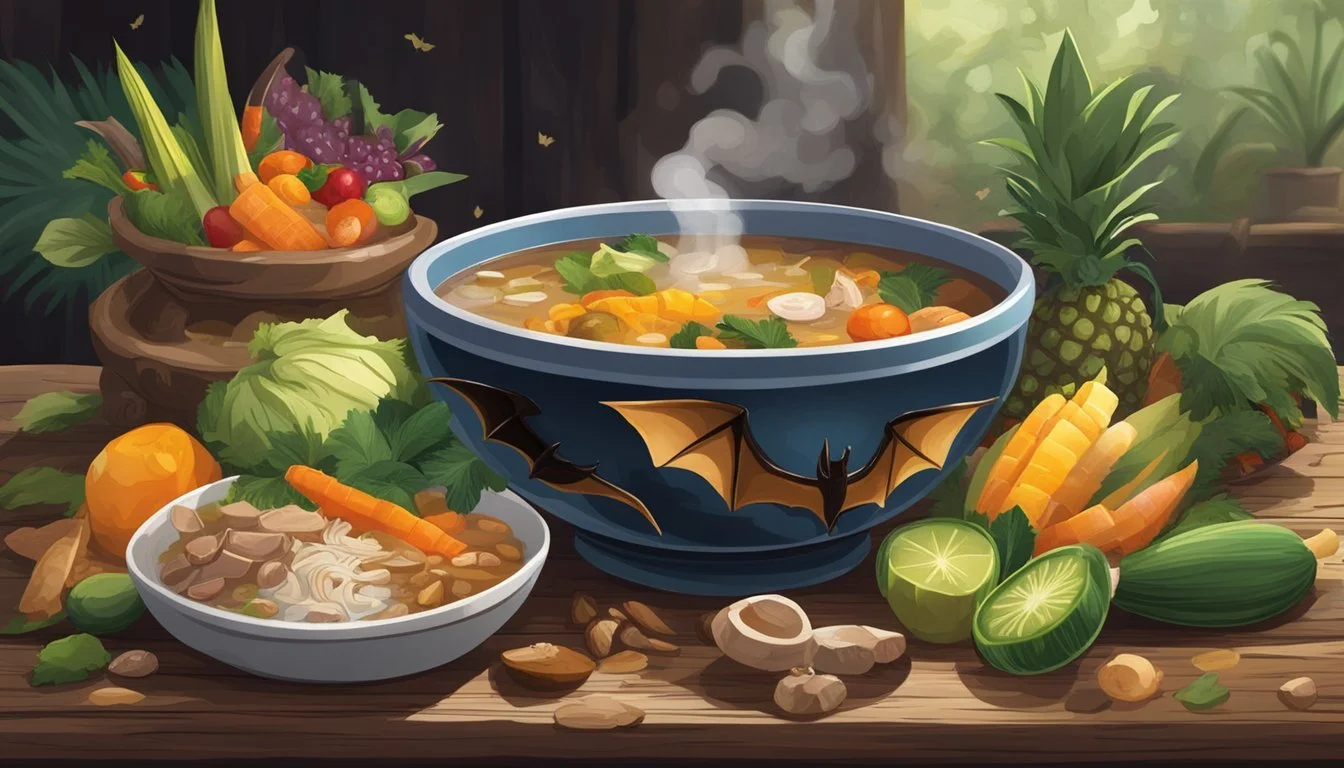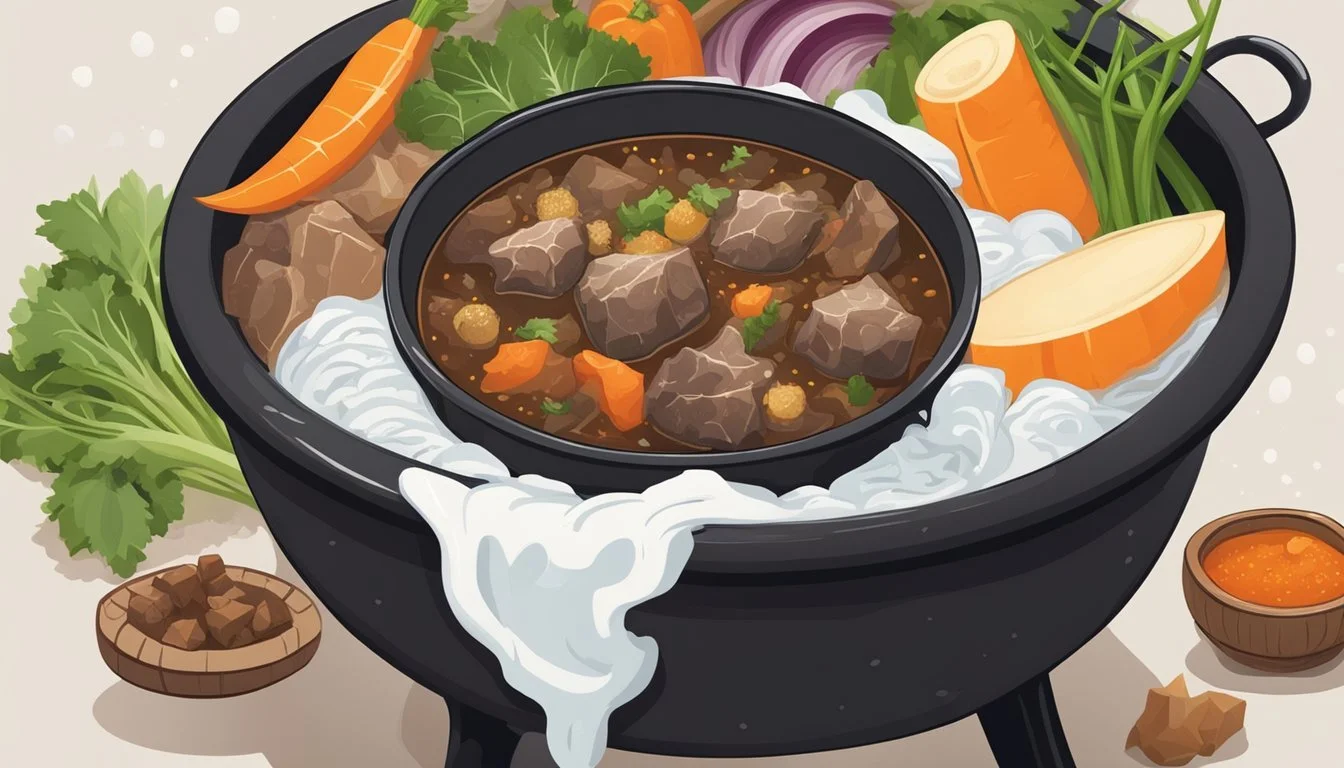Bat Soup
Unveiling the Daring Delicacy of Pacific Islands
Bat soup is a traditional delicacy found in the Pacific Islands, notably in Palau, where it is considered not only a culinary specialty but also an important part of local customs and traditions. Known for its unique flavor profile, which comes from the fruit bat species used in the dish, this soup offers a distinctive sweet and tangy taste due to the bats' fruit-based diet. Preparing bat soup involves an intricate process that includes thoroughly cleaning the bat before boiling it until tender, and often, the dish is enhanced with a variety of local spices and ingredients, like coconut milk or ginger, depending on the recipe.
While to some the idea of consuming bat soup might be surprising or even off-putting, it's a prime example of how varied and diverse global cuisines can be. In Palau and certain other regions of Micronesia, consuming bat soup is not only about savoring a meal; it's about embracing an integral part of their heritage and culinary practices. Each careful step in the preparation of this soup—from boiling to seasoning—attests to the rich food culture that is celebrated among the Pacific Islanders.
Cultural Significance
Bat soup, a dish with deep roots in Pacific Island culinary traditions, occupies a special place in the food culture of Palau. It reflects a history of resourcefulness and a connection to the natural environment.
Historical Context
In Palau, bat soup is more than just a meal; it is a traditional delicacy that has been prepared for generations. The practice of using fruit bats in cuisine is closely linked with the island's history and availability of natural resources. Bats, particularly because of their fruit-based diet, are a locally sourced meat that Palauans have historically utilized, which results in a unique flavor profile described as sweet meat. This dish has been historically significant for feasts and special occasions, showcasing the creative use of indigenous ingredients and the ingenuity of Palau's culinary practices.
Global Perceptions
Around the world, the consumption of bats is often met with skepticism due to concerns regarding diseases and unfamiliarity with the diet. Despite these perceptions, within Palau and other parts of the South Pacific, bat soup remains a culturally significant dish, reflecting the community's resilience and adaptation. Visitors to Palau may find that while bat is no longer as commonly consumed due to the availability of imported meats, the dish still symbolizes a link to the past and is a testament to the distinctive nature of traditional Pacific Island cuisine.
In conversations about traditional food from islands like Fiji and across the South Pacific, the emphasis on local ingredients and ancestral preparation methods foregrounds a deep respect for the environment and cultural continuity. Hence, while not universally embraced, traditional dishes such as bat soup are integral to the cultural identities of Pacific Island communities.
Ingredients and Preparation
Bat soup is a distinctive Pacific Island dish, characterized by its rich, flavorful broth and unique ingredients. Preparation of this traditional dish is a meticulous process that starts with sourcing specific ingredients and careful handling during cooking to ensure the soup's signature sweet and savory profile.
Key Ingredients
Bats: The primary ingredient, fruit bats, are valued for their naturally sweet-tasting meat due to their fruit-based diet.
Coconut Milk: Provides a creamy base to the soup, contributing to the dish's rich texture.
Ginger: Fresh ginger adds a piquant warmth and spice to the dish.
Spices: A variety of spices, potentially including onions, garlic, salt, and pepper, are used to enhance the dish's complex flavors.
Vegetables: Root vegetables and other types like carrots may be included for added taste and substance.
Rice: Often served as an accompaniment, rice provides a neutral counterpoint to the soup's intense flavors.
Additional Ingredients: Lemon juice or lime leaves, soy sauce, and occasionally honey may be used according to regional recipes or personal preference.
Preparation Steps
Cleaning: The bat must be thoroughly washed before cooking.
Broth: Start by boiling the bat to create a base broth or simmer it directly with other ingredients like ginger and spices.
Adding Vegetables: After the bat has simmered, incorporate vegetables into the pot and continue to cook until tender.
Coconut Milk: Coconut milk is then added to the mixture to form the creamy soup base.
Flavor Enhancements: Season the soup with salt, pepper, and soy sauce as desired, adjusting to achieve a balanced sweetness and savoriness.
Traditional Recipe
In a large pot, bat is boiled until the skin loosens and it becomes tender.
The bat is removed, and secondary ingredients such as ginger, fresh vegetables, and selected spices are added to the broth.
After these vegetables have cooked, the bat meat, along with coconut milk, is reintroduced to the pot.
The soup is simmered until all ingredients are cooked through and the flavors meld.
The dish is traditionally served hot, often alongside rice, seasoned to taste with elements like soy sauce or fresh lemon juice.
Nutritional Profile
Bat soup, a traditional dish in some Pacific Islands, notably Palau, carries a unique nutritional composition. This dish's primary component is fruit bat, known to contain various nutrients essential for human health.
Health Benefits
Fruit bats, the central ingredient in bat soup, are a source of protein, which is vital for muscle repair and growth. Protein also serves as a building block for enzymes and hormones. The soup, when prepared with additional vegetables and ingredients like ginger and coconut milk, contributes vitamins and minerals beneficial for the immune system and overall health. Ginger, for instance, contains potent anti-inflammatory properties and can aid digestion.
Dietary Information
Regarding its nutritional content, bat meat offers a different profile compared to common meats like chicken or beef. In general, wild game, including bats, is leaner and could be lower in fat, although comprehensive nutritional data on bat meat is scarce. The preparation method of boiling can help retain most nutrients without adding additional fat. However, bat soup may also contain coconut milk, which adds fats—primarily saturated fats. It's also notable that the dish includes little to no carbohydrates unless served with sides such as rice or vegetables. The additional ingredients like vegetables can offer fiber, while ginger provides a minimal amount of carbohydrates.
In conclusion, while bat soup has a distinct nutritional profile with benefits from its protein content and the vitamins and minerals from its additional ingredients, it is also crucial to consume it within the context of a balanced diet.
Regional Variations
Regional interpretations of bat soup reveal rich culinary diversity and adaptations, influenced by local ingredients and cultural preferences.
Pacific Island Versions
In Palau, the traditional recipe calls for boiling a whole fruit bat until tender, then enhancing the dish with coconut milk for creaminess and salt for flavor. Served with a side of hot sauce and rice, it is a testament to the ingenuity of utilizing local fauna and flora. The use of coconuts reflects the South Pacific's reliance on this versatile fruit for both culinary and cultural practices.
Adaptations Elsewhere
Bat soup finds iterations in other regions through the incorporation of different spices, vegetables, and even starches like taro or cassava. The variations are often dictated by the local palate and available ingredients, as coastal areas might favor a fish-based supplement and inland regions opt for poultry or pork when bats are less accessible or desirable.
Fiji's Take on Bat Soup
Moving over to Fiji, chefs there prepare bat soup in a similar vein to their Palauan counterparts, but might add unique Fijian flair with breadfruit or a blend of the islands' favored spices. Their use of indigenous staples like taro in the soup can also be found, acknowledging the root's significance in many South Pacific diets.
Safety and Health Considerations
When discussing bat soup, key considerations revolve around potential disease transmission and the establishment of safe consumption practices to mitigate health risks.
Disease Transmission
Bats are known reservoirs for a range of zoonotic viruses, including those that can cause severe diseases in humans. The risk of disease transmission from consuming bat meat, particularly if not prepared correctly, can be significant. Pathogens may be present in bat saliva, blood, and other bodily fluids, and handling these improperly can increase the likelihood of spillover events.
Viruses: Potential to carry rabies or coronaviruses.
Insects: Parasites or other insects that reside on bats may also carry diseases.
Safe Consumption Practices
To minimize health risks associated with bat soup, one should adhere to specific safe consumption practices. This involves proper preparation methods that ensure the bat meat is safe to eat.
Heat Treatment: High temperatures during cooking can reduce the risk of pathogens.
Handling: Proper handling during preparation to avoid cross-contamination.
It is essential to cook the bat thoroughly, ensuring that the meat reaches an internal temperature that is sufficient to kill any harmful pathogens. As bats are a protected species in some regions, one should also make certain that consuming the meat complies with local wildlife and conservation laws.
Serving Suggestions
When preparing bat soup, the accompaniments and presentation play a significant role in enhancing the dish's flavor and dining experience. Choosing the right sides and presenting the soup appropriately can elevate this traditional dish from a simple meal to a cultural experience.
Accompaniments
Bat soup is traditionally served with a variety of sides that complement its rich flavors. A staple accompaniment is cooked rice, which balances the soup's intensity and provides a neutral base. Including a carbohydrate like rice helps absorb the soup's savory broth and makes the meal more filling.
For those who prefer a richer flavor profile, coconut milk is often added to the dish, either mixed in the soup or served on the side. The sweetness and creaminess of the coconut milk can soften the robust taste of the bat meat. To enhance the aroma of the meal, adding spices such as cinnamon and cloves can introduce a warm and comforting note to the dish.
Presentation
The visual aspect of bat soup is as important as its taste and aroma. Presentation starts with how the soup itself is served. It is commonly dished in large bowls, with some cooks choosing to leave the bat intact to create an impactful visual. Bat soup can be served with hot sauce for those who appreciate an added kick.
For garnishing, fresh herbs or a sprinkle of spices like cinnamon can be used to not only add a pop of color but also an extra layer of flavor. To cater to different palates, especially those unfamiliar with the dish, one might consider serving seafood or fresh fish on the side to give an option with a familiar taste and a contrasting texture to the bat meat.
The Culinary Experience
In the Pacific Islands, fruit bat soup presents a unique flavor profile that may surprise those unacquainted with its traditional preparation and dining customs. This dish is considered a delicacy, reflecting the cultural heritage and bold culinary practices of the region.
Taste Profile
Fruit bat soup is known for its distinctive taste, which is a mix of earthy and gamey flavors punctuated by a creamy coconut milk base. The texture of the meat itself is tender, often compared to that of chicken but with a more pronounced, wild savoriness. Traditional seasonings include fresh ginger and local spices, which can introduce a slight heat or aromatic quality to the overall flavor. The inclusion of local vegetables like carrots can add sweetness and variety to the palate.
Dining Etiquette
Dining on fruit bat soup adheres to specific etiquette that enhances the experience. It's typically served in large bowls where the fruit bat may be presented whole, with the creature sometimes "staring back" at the diner. The proper way to eat fruit bat soup involves:
Chewing thoroughly: Since the soup includes an entire bat, bones and all, guests are expected to suck the meat from the bones carefully.
Utensil use: While spoons may be used for the broth, hands are often employed for handling the bat.
Respect for the dish: Acknowledging the significance of this dish to local culture is paramount. Diners are expected to approach it with an open mind and heart, embracing its role in the culinary landscape of the region.
Related Fijian Dishes
Fiji cuisine represents a blend of Pacific island flavors and Indian influences, marked by an abundance of fresh seafood and plant-based staples like taro and cassava.
Seafood Specialties
In the realm of Fijian seafood, Fish Suruwa stands out as a staple dish. This is a curried fish soup that infuses fresh fish with a blend of coconut cream, onions, tomatoes, garlic, and chili peppers. Often it's garnished with local herbs, such as coriander. Fiji's coastal proximity means fresh seafood is a cornerstone in many dishes, including ones featuring raw fish, mussels, (What wine goes well with mussels?) clams, (What wine goes well with clams?) sea urchins, sea cucumbers, oysters, lobster (What wine goes well with lobster?), and more.
Comfort Foods in Fiji
For comfort food, taro and cassava are essential, serving as the base in many traditional recipes. These starchy root vegetables are often paired with corned beef, reflecting a delightful mixture of local and introduced cuisines. Roti, a flatbread reflecting the Indian culinary heritage of Fiji, is usually enjoyed with goat curry or dahl, a lentil-based dish. Offal dishes, such as those including liver, are also considered comfort foods and are typically cooked during special occasions.










